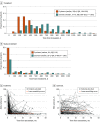Prognostic Value of Cutaneous Disease Severity Estimates on Survival Outcomes in Patients With Chronic Graft-vs-Host Disease
- PMID: 36884224
- PMCID: PMC9996455
- DOI: 10.1001/jamadermatol.2022.6624
Prognostic Value of Cutaneous Disease Severity Estimates on Survival Outcomes in Patients With Chronic Graft-vs-Host Disease
Abstract
Importance: Prior studies have demonstrated an association between cutaneous chronic graft-vs-host disease (cGVHD) and mortality. Assessment of the prognostic value of different measures of disease severity would assist in risk stratification.
Objective: To compare the prognostic value of body surface area (BSA) and National Institutes of Health (NIH) Skin Score on survival outcomes stratified by erythema and sclerosis subtypes of cGVHD.
Design, setting, and participants: Multicenter prospective cohort study from the Chronic Graft-vs-Host Disease Consortium including 9 medical centers in the US, enrolled from 2007 through 2012 and followed until 2018. Participants were adults and children with a diagnosis of cGVHD requiring systemic immunosuppression and with skin involvement during the study period, who had longitudinal follow-up. Data analysis was performed from April 2019 to April 2022.
Exposures: Patients underwent continuous BSA estimation and categorical NIH Skin Score grading of cutaneous cGVHD at enrollment and every 3 to 6 months thereafter.
Main outcomes and measures: Nonrelapse mortality (NRM) and overall survival (OS), compared between BSA and NIH Skin Score longitudinal prognostic models, adjusted for age, race, conditioning intensity, patient sex, and donor sex.
Results: Of 469 patients with cGVHD, 267 (57%) (105 female [39%]; mean [SD] age, 51 [12] years) had cutaneous cGVHD at enrollment, and 89 (19%) developed skin involvement subsequently. Erythema-type disease had earlier onset and was more responsive to treatment compared with sclerosis-type disease. Most cases (77 of 112 [69%]) of sclerotic disease occurred without prior erythema. Erythema-type cGVHD at first follow-up visit was associated with NRM (hazard ratio, 1.33 per 10% BSA increase; 95% CI, 1.19-1.48; P < .001) and OS (hazard ratio, 1.28 per 10% BSA increase; 95% CI, 1.14-1.44; P < .001), while sclerosis-type cGVHD had no significant association with mortality. The model with erythema BSA collected at baseline and first follow-up visits retained 75% of the total prognostic information (from all covariates including BSA and NIH Skin Score) for NRM and 73% for OS, with no statistical difference between prognostic models (likelihood ratio test χ2, 5.9; P = .05). Conversely, NIH Skin Score collected at the same intervals lost significant prognostic information (likelihood ratio test χ2, 14.7; P < .001). The model incorporating NIH Skin Score instead of erythema BSA accounted for only 38% of the total information for NRM and 58% for OS.
Conclusions and relevance: In this prospective cohort study, erythema-type cutaneous cGVHD was associated with increased risk of mortality. Erythema BSA collected at baseline and follow-up predicted survival more accurately than the NIH Skin Score in patients requiring immunosuppression. Accurate assessment of erythema BSA may assist in identifying patients with cutaneous cGVHD at high risk for mortality.
Conflict of interest statement
Figures


References
-
- Boyiadzis M, Arora M, Klein JP, et al. . Impact of chronic graft-versus-host disease on late relapse and survival on 7,489 patients after myeloablative allogeneic hematopoietic cell transplantation for leukemia. Clin Cancer Res. 2015;21(9):2020-2028. doi:10.1158/1078-0432.CCR-14-0586 - DOI - PMC - PubMed
Publication types
MeSH terms
Grants and funding
LinkOut - more resources
Full Text Sources
Miscellaneous

